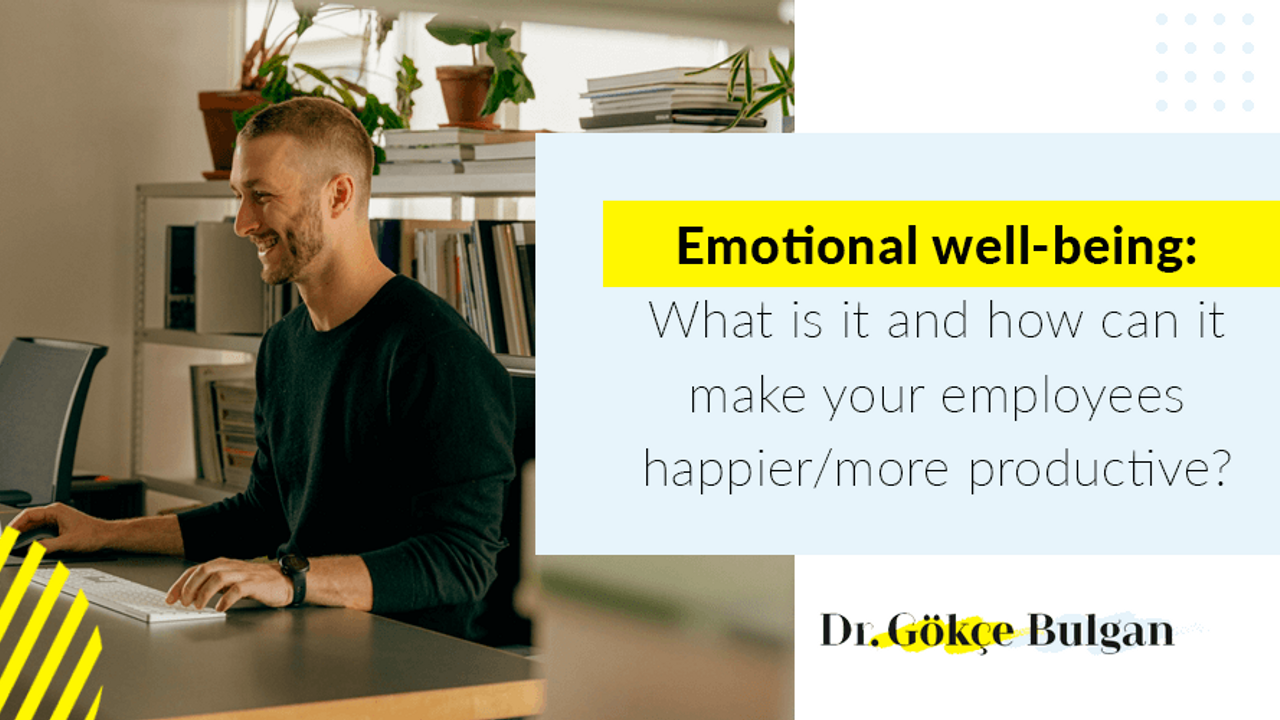Emotional well-being: What is it and how can it make your employees happier and more productive?

When I work with my clients, I’m often asked about how to improve employee emotional well-being.
This is one of my favorite questions because improving employees' emotional well-being has so many benefits to both the individual employee and the organization as a whole.
But first, what is emotional well-being?

Emotional well-being is our ability to regulate our emotions as we cope with the stresses and strains of everyday life and work.
When we have a positive state of emotional well-being we are able to handle difficult situations with an optimistic, proactive, problem-solving outlook.
If our emotional well-being is suffering, we struggle to cope with unexpected events, avoid tackling urgent problems and fail to make effective decisions.
Why is emotional well-being at work important?
A 2021 report by global analysis firm Gallup found that only 34% of Americans rated their emotional well-being as “excellent” – a record low.
Gallup also tracks a metric they call employee “engagement”; a measure of how enthusiastic and committed staff are to their workplace. High levels of engagement have a positive impact on productivity, customer service, staff health, and general well-being. In fact, research by Gallup has shown that an engaged, dedicated workforce increases profitability by 21%.
According to Gallup research:
“Engagement and wellbeing are reciprocal – each influences the future state of the other. They are also additive – each makes a unique but complementary contribution to the thoughts, feelings, behaviors, and performance outcomes of employees. When they work together, they are a super-charger for a thriving, productive workplace … when employees are engaged and thriving at work, burnout decreases and productivity improves.”
Emotional well-being and resilience

Work presents us with many challenges; from dealing with a difficult colleague, to calming an irate customer, or juggling a new office move whilst onboarding a new client – it helps if we can tackle these problems with a calm, non-judgemental, and resilient frame of mind.
In fact, “resilience” is a key part of emotional well-being. If we describe someone as “level-headed”, “stoical”, or “unflappable” we are talking about resilience. We are talking about experiencing high levels of emotional well-being.
The modern workplace is constantly evolving, as anyone who had to get used to remote work, back-to-back zoom meetings, and social distancing knows only too well. But even before the pandemic our working lives were getting more and more unpredictable, and the boundaries between work and leisure blurred thanks to mobile devices, and a growth in social media and communications technology, amongst other factors.
A 2019 survey of baby boomers found that the average person has 12 jobs in a lifetime, spending around 4 years in each role – but for many millennials and younger generations that figure is likely to be much, much higher; unless they find a workplace that can keep them happy and engaged, that is.
My blog post on preventing employee burnout is a good companion piece to this post: in it, I talked about how “The Great Resignation” has disrupted working life around the world. For some people, like Ranjay Gulati of Harvard Business School, it’s not so much a great resignation, as it is a “Great Rethink”; as people seek greater meaning and purpose in their working lives.
What is the connection between emotional well-being and mental health?
Emotional well-being is not the same as mental health. Emotional well-being, sometimes called emotional wellness, refers to the way we manage and respond to the emotions we experience.
It’s possible to have poor emotional well-being and good mental health, or to have poor mental health and good emotional well-being. For example, an employee who wakes up at 4am worrying about an upcoming meeting is experiencing a disturbance to their emotional well-being.
They may not suffer from any other symptoms associated with conditions like anxiety or depression. Once they take a break from work, the emotional disturbance eases. This is not the case with mental health, which often requires a deeper, more therapeutic approach.
Of course, there is often a link between poor emotional well-being and deteriorating mental health. Sustained stress from an inability to handle a demanding work situation could lead to depression. Alternatively, someone who has suffered from anxiety for years may experience less distress once they learn how to improve their ability to handle stressful situations.
Poor emotional well-being can lead to mental health problems

Emotional well-being and mental health can both reinforce each other, in positive or negative directions. Improving well-being is important if we are to prevent mental health issues from developing. Poor mental health can lead to much greater absenteeism. A study of the UK labor market found that “people with a chronic health condition are more likely to be absent from work, and mental health has a significantly larger effect than physical health.”
Not only this, but mental health can drive greater rates of “presenteeism”; which is when workers show up to work, but aren’t productive. Whilst absenteeism such as unscheduled sick days is easy to spot, presenteeism is much harder to identify because all the surface signs of being productive are there. And it’s much more costly, hitting US companies to the tune of more than $150bn every year.
By improving employee well-being in your workplace, you’ll not only be creating a positive, inspiring place to work, but you’ll also be on the path to unlocking supercharged business performance.
A workforce with high levels of emotional well-being also makes things much easier for leaders and management. When employees are willing to tackle hard problems directly and feel empowered to do so in a productive way, your managers won’t have to impose discipline from above; they’ll have a much more relaxed, constructive role to play in facilitating workplace performance – and staff and management will all be happier for it.
Creating a happy, engaged workforce requires improving emotional well-being.
So how exactly can you improve emotional well-being at work?
How can you improve emotional well-being at work?
We’ve seen the surprising impacts of poor emotional well-being at work:
● Falling productivity
● Poor staff morale
● Reduced profits
● High employee turnover
The good news is that boosting emotional well-being at work is easier than it seems – with the right support and guidance. Let’s take a look at how we can do this.
Emotional awareness
A key part of managing emotional well-being is to be aware of the emotions you experience, and how you react to them. Do you get stressed about an upcoming presentation… only to get mad at yourself for over-reacting? Are you too nervous to confront a difficult colleague, only to feel resentful that you’re not being heard? This is a sign your emotional well-being is on shaky ground.
The first step to gaining control over your emotional reactions is through mindfulness. Mindfulness teaches you to not get too caught up in your emotions, but to acknowledge them in a non-judgemental way. With this foundation, you can have greater control over how you respond to your emotional inner world.
Communication and emotional well-being
It’s important to be able to communicate how you are feeling in a constructive way. If you are frustrated with a team member, rather than “lashing out” at them, have a conversation about how you can work together to resolve the issue.
Communication isn’t just about talking… it’s also about listening. If you listen – and I mean, actually listen – to someone you’re in conflict with, they will feel heard. This can reduce any feelings of frustration or resentment that they might have – issues that may be fueling your disagreement. Remember: communication is a two-way street. Usually, through the practice of mindful communication, it’s possible to resolve issues to the benefit of both parties.
Building emotional resilience in the workplace
Resilience plays a crucial role in emotional well-being, especially at work. The foundations of workplace resilience are:
● An optimistic outlook
● Management of difficult or extreme emotions
● A safe work environment
● Social support networks
With this suite of emotional management tools in place, it’s possible to confront the complex demands of the modern workplace without succumbing to stress and disappointment.
Leadership and emotional well-being
Emotional wellness doesn’t just affect employees; leaders face many challenges that can easily disrupt their well-being. Ironically, a lot of the factors that cause stress in leaders – dealing with disorganized teams, mediating internal conflicts, struggling to hit targets – can filter downwards to staff, reinforcing any existing issues and making them harder to resolve.
To escape from this downward spiral of reinforcement we need to actively create a workplace culture that is aware of the importance of emotional well-being for both leaders and employees.
Emotional well-being and structural change
Fostering a greater awareness of emotional well-being at work is of course extremely important. But it’s also important to look at the structures and processes you have in place, and ensure that your teams are set up for success – not failure. This means setting clear goals for each team member; so that everyone is aware of the role they are playing, and what their responsibilities are.
Clear goals need to be coupled with processes that empower your employees to be proactive and take initiative. This means setting realistic goals so that everyone can track team achievements; encouraging the open flow of communication and feedback so wins can be monitored, and your team can adapt to changing situations.
Effective workplace leadership is not just about facilitating productive working processes; it’s also about ensuring appropriate boundaries between work and leisure. A happy, productive workforce is a well-rested, properly compensated workplace. This means giving your employees regular breaks – and fear not; this will actually increase productivity, not diminish it.
Proper rest means proper holidays, so encourage your staff to take their vacation allowances. Leaders are often the most likely to neglect taking time off. This can send a signal to staff that time away from the office is frowned upon. Encourage your leaders to also take their vacations. This can be as simple as encouraging everyone to set out-of-work messages to prevent them from feeling the pressure to respond to emails, deleting or muting internal communications channels to get proper distance from work stresses, and people to pursue hobbies and interests outside of work – there really is such a thing!
I hope you’ve enjoyed this guide to emotional well-being at work, and have lots of ideas about how to make your workplace a happy, thriving, productive place of shared goals and motivated staff.
If you want support developing greater emotional well-being, my Mindfulness-Based Well-Being at Work Program is specially designed to help improve mental and emotional well-being using evidence-based practices informed by the latest neuroscience research. Contact me to find out how I can empower your team to be happier and more productive.

